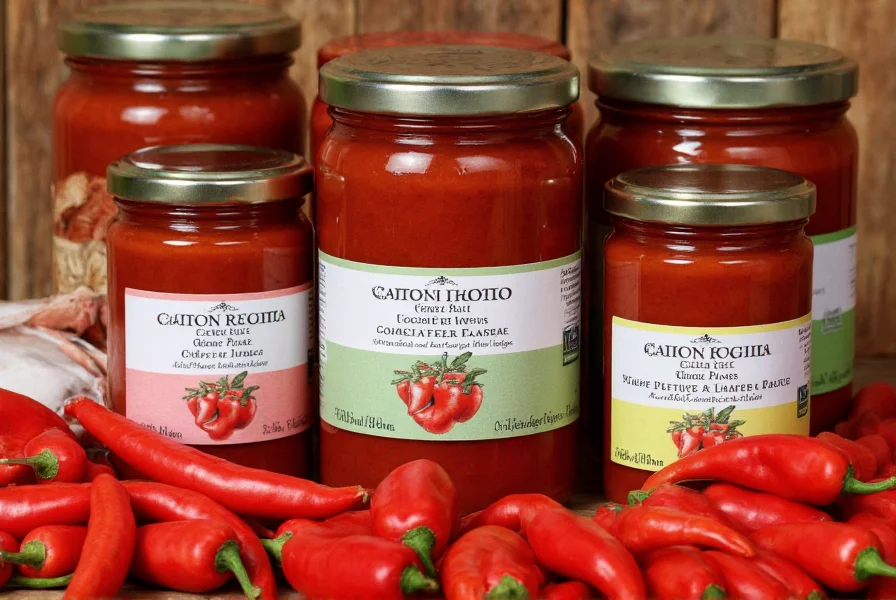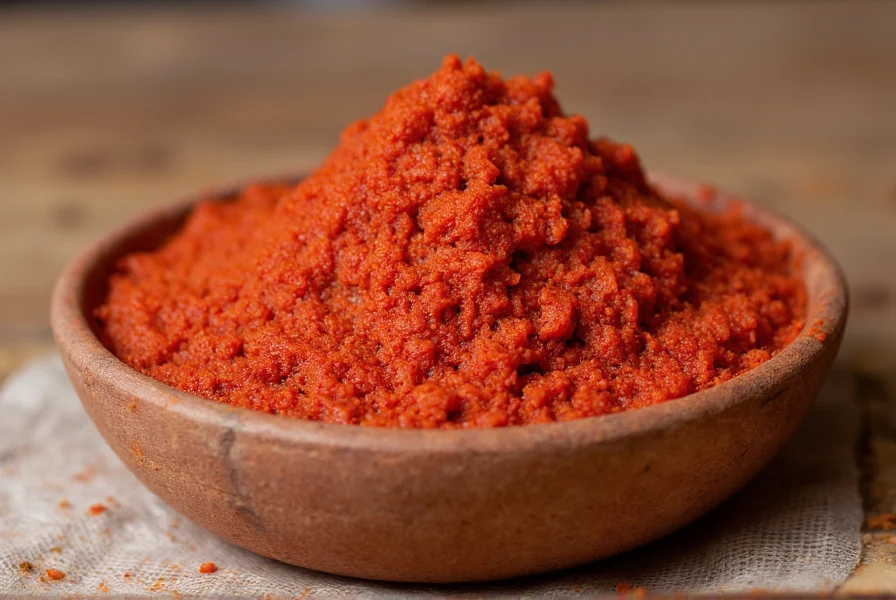Originating from Italy's southern Calabria region, this traditional condiment has gained international popularity among chefs and home cooks seeking authentic Mediterranean flavor. Unlike generic chili pastes, Calabrian chili pepper paste features a unique balance of heat and fruitiness that elevates dishes without dominating them.
What Makes Calabrian Chili Pepper Paste Unique
Calabrian chili peppers (peperoncino diavolicchio calabrese) grow exclusively in Calabria's mineral-rich soil and Mediterranean climate. These small, tapered peppers range from bright red to deep crimson when mature. The paste preserves both the fresh and slightly fermented characteristics of these special peppers.
The traditional preparation involves roasting or sun-drying the peppers before blending them with extra virgin olive oil, salt, and sometimes garlic or citrus. Authentic versions contain no preservatives or artificial ingredients. The resulting paste has a smooth but textured consistency with visible flecks of pepper skin.

Flavor Profile and Heat Level
Understanding Calabrian chili pepper paste's flavor characteristics helps you use it effectively in cooking:
| Characteristic | Description |
|---|---|
| Heat Level | Moderate (25,000-35,000 Scoville units) - comparable to cayenne but with more complexity |
| Flavor Notes | Berry-like fruitiness, subtle smokiness, bright acidity, earthy undertones |
| Texture | Smooth with visible pepper flakes, oil separation is normal |
| Color | Vibrant red to deep crimson |
This distinctive combination makes Calabrian chili paste more versatile than many hotter alternatives. The moderate heat allows you to add significant flavor without making dishes uncomfortably spicy.
How to Use Calabrian Chili Pepper Paste in Cooking
Chefs appreciate Calabrian chili pepper paste for its ability to enhance rather than dominate dishes. Here are practical applications:
- Pasta dishes: Stir 1-2 teaspoons into tomato sauces, olive oil-based pastas, or creamy sauces for subtle heat
- Seafood preparation: Mix with olive oil and lemon for a vibrant marinade for fish or shrimp
- Meat rubs: Combine with herbs and olive oil for chicken, pork, or lamb
- Vinaigrettes and dressings: Whisk into olive oil and vinegar for salad dressings with depth
- Vegetable enhancement: Toss roasted vegetables with a small amount before serving
- Breakfast boost: Mix into scrambled eggs or avocado toast
When working with Calabrian chili paste, remember that a little goes a long way. Start with ½ teaspoon per serving and adjust to taste. The paste's flavor develops when heated, so add it early in the cooking process for integrated heat or at the end for brighter, more pronounced pepper flavor.
Storage and Shelf Life
Proper storage maintains Calabrian chili pepper paste's quality:
- Store unopened jars in a cool, dark pantry for up to 18 months
- After opening, keep refrigerated in an airtight container
- Always use clean utensils to prevent contamination
- Top with a thin layer of olive oil to create a protective barrier
- Consume within 3-4 months after opening for best flavor
Some separation of oil is normal and indicates authenticity. Simply stir gently before using. Discard if you notice mold, off odors, or significant color changes.
Finding Authentic Calabrian Chili Pepper Paste
When shopping for genuine Calabrian chili pepper paste, look for these markers of quality:
- Ingredients listing only Calabrian peppers, olive oil, salt (and possibly garlic)
- Origin specification: "Product of Italy" or "Made in Calabria"
- Traditional Italian brand names like Podi' di Terravecchia, Il Calabrese, or Peperonata Calabrese
- Paste with visible pepper flakes rather than completely smooth texture
Major grocery chains often carry Calabrian chili paste in the international or specialty foods section. Italian specialty markets typically offer the widest selection of authentic brands. Online retailers provide access to premium Italian imports directly from Calabria.

Substitutes for Calabrian Chili Pepper Paste
If you can't find authentic Calabrian chili pepper paste, these alternatives work in a pinch:
- Red pepper flakes + roasted red peppers: Blend 1 part red pepper flakes with 3 parts roasted red peppers and olive oil
- Chili garlic paste + lemon zest: Mix with extra virgin olive oil to mellow the garlic flavor
- Harissa paste: Use half the amount as Calabrian paste (harissa is typically hotter)
- Chipotle in adobo: Provides smokiness but different fruit profile
Remember that substitutes won't perfectly replicate Calabrian paste's unique flavor profile, but they can provide similar heat levels and functionality in recipes.
Traditional Calabrian Recipes Featuring the Paste
Authentic Calabrian cuisine showcases this paste in simple preparations that highlight its flavor:
Spaghetti Aglio e Olio con Peperoncino
This classic Calabrian preparation transforms basic ingredients into something extraordinary:
- Cook 12 oz spaghetti until al dente
- Heat ¼ cup extra virgin olive oil with 4 crushed garlic cloves
- Add 1-2 teaspoons Calabrian chili paste (adjust to heat preference)
- Toss hot pasta in the oil mixture, adding pasta water to emulsify
- Finish with fresh parsley and pecorino cheese
Calabrian Spiced Roasted Vegetables
A versatile side dish that complements meats and fish:
- Toss mixed vegetables (eggplant, zucchini, bell peppers) with 2 tablespoons olive oil
- Add 1 teaspoon Calabrian chili paste and salt
- Roast at 400°F (200°C) for 25-30 minutes until caramelized
- Finish with lemon zest and fresh herbs
FAQ Section
Is Calabrian chili pepper paste the same as Calabrian chile paste?
Yes, Calabrian chili pepper paste and Calabrian chile paste refer to the same product. The variation in spelling (chili vs. chile) reflects regional language differences but describes identical Italian condiments made from Calabrian peppers.
How spicy is Calabrian chili pepper paste compared to other hot sauces?
Calabrian chili pepper paste registers between 25,000-35,000 Scoville units, making it moderately hot—comparable to cayenne pepper but milder than habanero or ghost peppers. Its heat is balanced by distinct fruity notes, creating a more complex flavor profile than many single-note hot sauces.
Can I make Calabrian chili pepper paste at home?
Yes, you can make homemade Calabrian chili pepper paste by roasting ripe Calabrian peppers (or suitable substitutes like cayenne or Fresno peppers), removing seeds, then blending with extra virgin olive oil and salt. Authentic versions require Calabrian peppers, but you can create a similar flavor profile using available ingredients. The homemade version typically lasts 2-3 weeks refrigerated.
What dishes pair best with Calabrian chili pepper paste?
Calabrian chili pepper paste complements pasta dishes, seafood preparations, roasted vegetables, meat marinades, and salad dressings. Its balanced heat and fruitiness enhance tomato-based sauces, olive oil preparations, and creamy dishes without overwhelming other ingredients. Traditional pairings include spaghetti, grilled fish, roasted eggplant, and simple vegetable preparations.
Does Calabrian chili pepper paste need refrigeration after opening?
Yes, refrigerate Calabrian chili pepper paste after opening to maintain freshness and prevent spoilage. Properly stored in an airtight container with a thin layer of olive oil on top, it will keep for 3-4 months. Unopened jars can be stored in a cool, dark pantry for up to 18 months.











 浙公网安备
33010002000092号
浙公网安备
33010002000092号 浙B2-20120091-4
浙B2-20120091-4